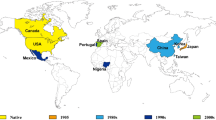Abstract
Wood-to-bark adhesion strengths were tested at 25 to −78°C under moisture contents of 0–200%. The freezing temperature of the cambium appeared to be between –20 and −40°C. The low freezing temperature was assumed to be due to the high pectin and protein contents in the cambium cells. At temperatures above the freezing point of the cambium (−20 to 25°C), the adhesion strength was curvilinearly and negatively related to moisture content. At temperatures below the freezing point of the cambium (−40 to –78°C), adhesion strength was not correlated with moisture content. For practical application, maintaining logs at high moisture content and temperatures above –20°C would assure a good debarking and yield high quality wood chips for pulping, with less wood loss to hog fuel.








Similar content being viewed by others
References
Allsopp A, Misra P (1940) The constitution of the cambium, the new wood and the mature sapwood of the common ash, the common elm and the Scotch pine. Biochem J 34:1078–1084
Fiscus ML, Van Eperen RH, Einspahr DW (1983) Method for obtaining wood/bark adhesion measurements on small samples. Wood Fiber Sci 15(3):219–222
Hillis WE (1987) Heartwood and tree exudates. Springer, Berlin Heidelberg New York, p 90–92
Jessome AP (1977) Strength and related properties of woods grown in Canada. Canadian Forest Service, Forestry Technical Report 21, p 37
Kubler H (1990) Natural loosening of the wood/bark bond: a review and synthesis. Forest Prod J 40(4):25–31
McIntosh DC (1948) Chemical treatment of trees. Pulp Paper Mag Can 49(7):117–120
Miller DJ (1975) Treatments to loosen bark. Forest Prod J 25(11):49–56
Springer EL, Hajny GJ, Feist WC (1971) Spontaneous heating in piled wood chips. II. Effect of temperature. Tappi 54(4):489–591
Thornber JP, Northcote DH (1961a) Changes in the chemical composition of a cambial cell during its differentiation into xylem and phloem tissue in trees. 1. Main components. Biochem J 81:449–455
Thornber JP, Northcote DH (1961b) Changes in the chemical composition of a cambial cell during its differentiation into xylem and phloem tissue in trees. 2. Carbohydrate constituents of each main component. Biochem J 81:455–464
Wilcox HE, Czabator FJ, Girolami G (1954) Seasonal variations in bark-peeling characteristics of some Adirondack pulpwood species. J Forest 52(5): 338–342
Wilson BF (1964) A model for cell production by the cambium of conifers. In: Zimmerman MH (ed) The formation of wood in forest trees. Academic, NY, pp 19–36
Author information
Authors and Affiliations
Corresponding author
Rights and permissions
About this article
Cite this article
Chow, S., Obermajer, A. Wood-to-bark adhesion of subalpine fir ( Abies lasiocarpa) in extreme temperatures. Wood Sci Technol 38, 391–403 (2004). https://doi.org/10.1007/s00226-004-0247-3
Received:
Published:
Issue Date:
DOI: https://doi.org/10.1007/s00226-004-0247-3




